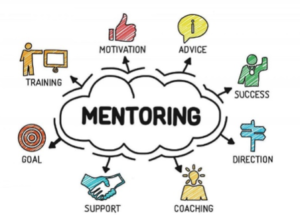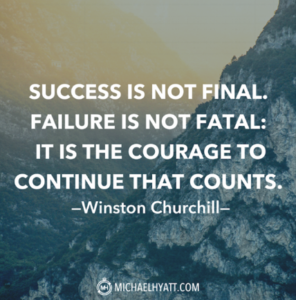10 Tips for a Mindset of Leadership
10 Tips for a Mindset of Leadership
Tip 1: Be a Great Follower
Yes, you read that right. Tip number one to successfully living leadership, is to first, and continually, become a great follower.When many professionals talk about the Mindset of Leadership, they often seem to miss a step. That is, most leaders don’t become leaders right out of the gate. There’s a saying that goes: “Smart people learn from their own mistakes. Smarter people learn from the mistakes of others. The smartest people learn from the successes of others.”
Today, I both follow and lead. These are not mutually exclusive. I follow people like Jesse Itzler, Johann Hari, and Andrew Yang. I lead the mission of Mental Fitness and act as a model for those who also believe in the mission.But for those I follow, I do not do so passively. I actively promote their causes. I paid for and attended Jesse’s Itzler’s Life Resume training course and bought a seat for my friend. I promote Johann Hari’s books to my clients to enhance their knowledge of the true roots of mental health and addiction. I promote Andrew Yang’s plan for a Universal Basic Income as a means to remove abject poverty to just about anybody who wasn’t to listen.
In return, leaders must act as great mentors. Mentors act as guides. They show us a path that works and reduce the learning curve when tackling something new.
How to Find Great Mentors
To find a great mentor, there are two important principles to follow:
- Reach out
- Reach up
Much like the idea of seeking support, finding a mentor is not a passive process. It takes active “reaching out” efforts to find a truly inspiring, knowledgeable, and willing mentor.Do your research. Why do you want to meet with this person? If you can’t answer this question clearly and enthusiastic, what’s the point of the meeting? Is this person truly the right mentor for you? Strategic reaching up involves reaching up to those who are ahead of you in order to learn about the next level, but not so far ahead of you that they’re unreachable.
Tip 2: Hustle Muscle
It is often said that Thomas Edison failed 1000 times before successfully inventing the prototype of the light bulb. When a reporter asked Edison how it felt to fail 1,000 times, Edison replied: “I didn’t fail 1,000 times. The light bulb was an invention of 1,000 steps.”
We learn infinitely more from doing and failing than thinking and stalling!
So how does one acquire Hustle Muscle?
Earlier in my career, taking the mentor tip previously mentioned, I joined a group private practice founded by a man I greatly admired. Though this man had many incredible attributes, he was also the quintessential dreamer. As such, he continual held the belief that someone else (besides himself) ought to take it upon themselves to spread his message. He truly, but wrongly, believed that if his message was strong enough, someone else would spread it for him.
The trouble with this belief was that I was putting the responsibility for my success based solely on someone else’s efforts. I had fallen deep into the Dreamer’s Trap and even found myself making excuses to stay stuck there. The conditions weren’t perfect so there was always an excuse that became a non-starter. It was around this time that I read Grant Cardone’s book, The 10x Rule. Many times throughout the book, Grant repeats “Success is your duty, responsibility and obligation.” Indeed, “Hustle Muscle” itself is a term I first heard from Grant and I’ve loved it ever since. Thanks Grant! I appreciate your inspiration and attitude.
Tip 3: Dream Big
I believe we all have Big Dreams within us. I can’t tell you what your Big Dream should or ought to be. That’s what makes writing about Big Dreams kind of tough. I can offer a guidance for one’s mindset, your Big Dream is not my Big Dream. Your Big Dream exists within you as mine does within me.
Nevertheless, in order to best help you find and achieve your Big Dream and your full potential, allow me to share some of my Big Dreams as models. Some I’ve accomplished. Some are in the works. Some are still just, well, dreams…The key to achieving Big Dreams is to never lose faith in ones’ self. One can do this by using and leveraging the self-fulling prophecy to challenge one’s self to live up to their own self-appointed reputation.
YOU DON’T NEED SOMEONE ELSE TO BELIEVE IN YOU FOR YOU TO BELIEVE IN YOURSELF!
You don’t need someone to label you as “gifted” or “intelligence” for you to become successful. The only labels that matter are the ones we give ourselves! So why not give yourself in incredible reputation to live up to? If one is to achieve a Big Dream, the first step is allowing one’s self to dream. Secondly, it’s to achieve Hustle Muscle. Third, is to keep believing in yourself throughout the process (and enjoy it a bit too)!
Tip 4: Get help!
Not only do highly successful people rely on mentors, but they also create great support teams. Fortunately, I’ve been blessed to have both. Getting to this point has been a combination of great fortune and persistent seeking. When working to achieve any Big Dream, there comes a time when doing it all yourself will no longer make sense. The mission will become bigger than any one person could ever achieve alone.
For me, these scales tipped right around July of 2019. My private practice was thriving, but as a solopreneur, I could no longer afford to take new referrals. I was also spending so much time on administrative work that it was taking away significant time that I could be using in seeing clients, creating new content, or speaking. Fortunately, I was able hire some incredible teammates!
Our Mental Fitness Team
Every Big Dream comes with a Support Team!
Tip 5: Find a Way or Find an Excuse
To best illustrate this principle, I’d like to share a little story of mine I’ve titled…“When the world says ‘No,’ call the CEO.”
Back in February of 2019, our furnace recently crapped out at our home. This was really bad timing, as the low that week hit 1-degree Fahrenheit, but fortunately, we had a home warranty! This is where the story gets interesting: I called the home warranty company and a service tech came to our home the next day. He said the heat exchanger was broken and that it would be $1350 to fix.
Between the fast talk and fine print, I couldn’t get a straight answer out of him so I called in to customer service. Finally, I got a hold of a representative who said she’d call me back after she reached out to the tech. I waited a day, no call. I called back. Same story. Same no call. Still no heat! At this point, simply paying still felt a bit like giving up to me, so I decided to take a different route.
First, I googled to find the company’s Wikipedia page. Second, I found out the name of their CEO. Third, I tried to direct message him on LinkedIn to get an answer. When I found out it would cost money to do that, I again did a google search to find the corporate phone number. I called the corporate line and typed his name into the directory and left a polite, but very to-the-point, message. No response. I called back the next day and did the same thing.
At this point I’m thinking, “I’m just going to Andy Dufrense this guy until he answers me.” I’m guessing he must have sensed this as well. Lo and behold, the next day, I get a call from corporate. And finally, a few months later, I got a check in the mail for all $1350! My point in sharing this story is this: I listen to advice from a lot of highly successful people, Jesse Itzler, Rachel Hollis, etc. What they all seem to have in common is that, even when they get an initial “No,” they don’t give up!
So whether it’s a business venture, a book, a relationship, or simply a dream, don’t give up on your goals. If you want it enough, you’ll find a way!
Tip 6: Respect the Process
Achieving any Big Dream doesn’t happen overnight. It’s process and it ought to be that way. If one were to achieve any goal overnight, it just wouldn’t be that rewarding to achieve. Rather, it’s a process of chipping away at something until the goal is accomplished.
There was popular commercial a few years ago for a certain college. Basically, the commercial’s point was this: In four years from now, you can be four years older and have a degree or be four years old without a degree. The choice is yours. I believe the reason this commercial stuck with me even years after it has stopped airing is because of the point it illustrates. Time will pass. Why not pass that time working towards something that will help you improve your life?
At First, Say YES
(A better way to find your niche)
Perhaps this may seem like common sense, to just say “yes” and get started. However, in recent years there’s been a push to “Find One’s Niche.” That is, to start by focusing one’s energy to a particular segment of population, or, to limit one’s focus to a highly specialized service of activity. While this may be great advice for an expert, it’s terrible advice for a novice. For an expert, it makes perfect sense to harness one’s focus to best match her or his expertise. However, it’s equally terrible advice for someone actively finding their niche (their path, their passion, their lane, their style, their client base, whatever it is you want to call it).
Typically, one thinks of knowledge as an asset not a curse. However, for one who is already successful and established, they tend to forgot the actual route it took them to get there and mistakenly think, perhaps I can help reverse engineering this path for others to expedite their process. In short, they’re wrong. There is no “secret.” There is no cheating the process of great achievement.
This “Say Yes, Take Action, Stumble On” approach is, for me, the better path to success. Yes, it comes with stumbling blocks and hardships, but those are unavoidable, so why not embrace them? It is not only more natural to the growth process, but also more effective.
Tip 7: Embrace Failure
From a young age, Spanx founder Sara Blakely was encouraged to take risks.
According to https://www.businessinsider.com, Blakely (Jesse Itzler’s wife) said her dad used to invite her and her brother to share their failures at the dinner table. Instead of being disappointed or upset, he would celebrate their efforts. “What it did was reframe my definition of failure,” Blakely said of the tradition. “Failure for me became not trying, versus the outcome.”
Eventually, Blakely began to find value in her shortcomings.
While Blakely thinks “so many people don’t take risks for fear of failure,” she isn’t one of them. Despite having next to no knowledge about fashion design, retail, or business, she believed in the idea for her now-ubiquitous shape-wear company wholeheartedly. She spent two years — and $5,000 of her own money — diligently patenting the idea, finding a hosiery manufacturer, prototyping the product, and successfully pitching it to Neiman Marcus, all while working a full-time job.
If you’re not failing often, you’re either not trying hard enough or you’re setting your bar too low. As a society, we ought to reframe the way we think of failure, and rather, celebrate the process instead!
Tip 8: Invest in Yourself
Many people I work with want to get rich, however, to do so they often bet on sports games or try to learn day trading. Perhaps some of my “wiser” clients may invest in the stock market or real estate. While this is all well and good (to each her or his own, all things in moderation), but all of things investments have variables that are largely outside of one’s control. This makes the investment inherently risky and unpredictable.
An investment in one’s self, however, is an investment YOU CAN CONTROL. Truly your success is up to you and you can 100 percent control your own efforts! So what’s the best way to invest in one’s self? Always be Learning. Want to make it to the top of your field and achieve your full potential? Never. Stop. Learning.
Tip 9: Priorities and Sacrifices
To achieve anything great in life, requires great sacrifice on focus on one’s priorities.
Full disclosure, I bought my first home before my first smart phone. This was back in April of 2015, and all but two or three of my friends had smart phones at the time. Needless to say, I took some flak for still rocking the “dumb” phone. And though it seemed crazy to some of my friends, I knew what my priorities were and I knew what I was willing to sacrifice to achieve them.
So let me ask you this: What’s the Big Dream that you’d like to achieve? If your goal has anything to do with starting your business, according to the Kauffman Foundation, the average cost to launch a startup is around $30,000. For the average American (myself included), that’s no small chunk of change! And yet, if achieving a goal is truly going to be a priority of yours, the next question that must be asked is “What am I willing to sacrifice to achieve it?”
It doesn’t have to be all money related either. Perhaps it’s sacrificing a week’s vacation to the beach to instead write your memoir. Perhaps it’s cancelling cable to free up a few hours in your evening to go back to school.If you really want to make this tip actionable, perhaps take a moment within the next week and write out some of your priorities in life. Then, write down an equal of your top expenditures. Notice any glaring discrepancies?
In short, no Big Dream is ever accomplished with an equal amount of sacrifice. Are you willing to give what it takes?
Tip 10: Take Calculated Risks
In June of 2019, I knew my business had outgrown its humble beginnings. My caseload was full. Howard’s one day a week with me involved us sharing the same windowless office, and I was starting to turn down clients. I knew this was my opportunity to expand, but to be frank, it scared quite a bit. I was profitable as a solopreneur. I was comfortable. Expansion would mean increased risk, new upfront capital investments, new learning curves, and growing pains.
Nevertheless, I knew the time for a calculated risk was now. I asked myself, “What’s the worst that could happen?” I ran the numbers and knew, even if everything fell through, I would still be okay. Rent bills are due immediately, but insurance companies take their time. There was no website, no logo, no real planning beyond just a “commit, and figure it out along the way” attitude. Fortunately, over the course of the next year, I was able to survive this pinch and fill my caseload.
Then, without even realizing it, this month (October 9th, more specifically) was the two-year anniversary of Mental Fitness! What a journey it’s been so far…to anyone who has ever started or dreamed of starting their own business, it’s tough! So to all those who have supported us in this dream, I thank you! Achieving your full potential IS POSSIBLE with the right mindset and support. Here’s to an even better Year Three!
And here’s to your Big Dreams as well! No great achievement was ever accomplished without an equal amount of risk and sacrifice, but if you believe in the mission strongly enough, it will all be worth it in the end!
Summary
- Be a Great Follower
- Hustle Muscle
- Dream Big
- Get Help
- Find a Way, Not an Excuse
- Respect the Process
- Embrace Failure
- Invest in Yourself
- Priorities and Sacrifices
- Take Calculated Risks
Image Source: https://www.entrepreneur.com/article/248740




